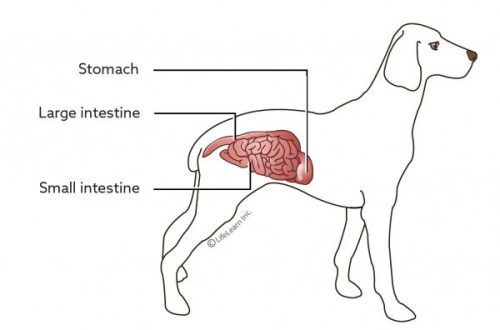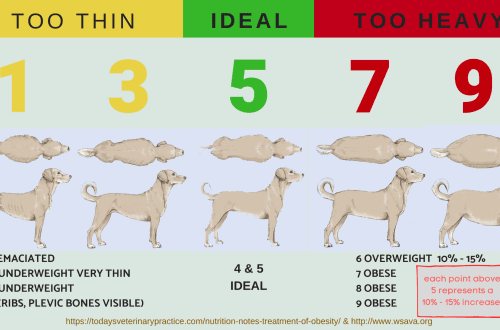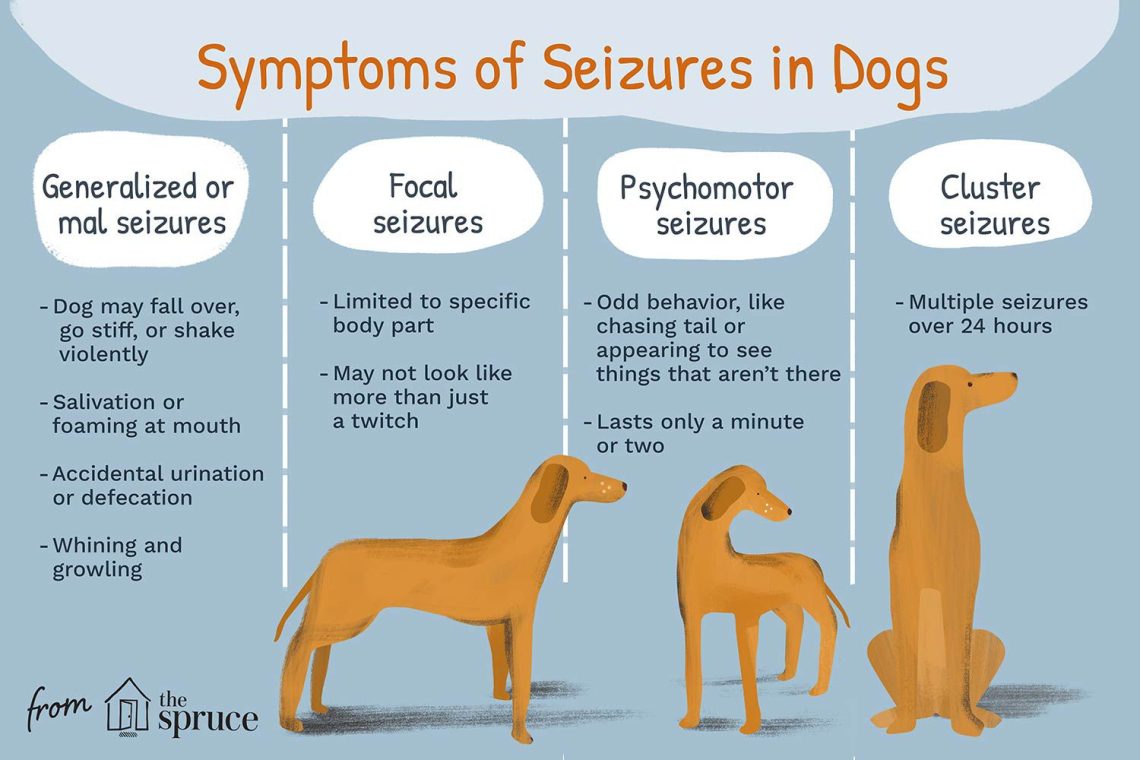
Epilepsy in a dog – all about seizures, causes and treatment
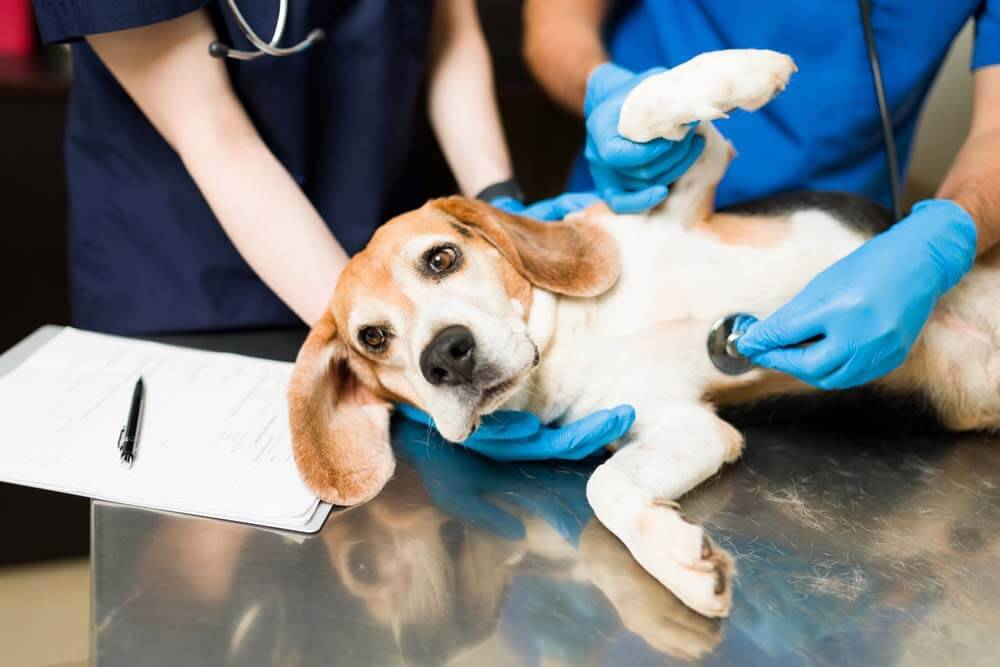
Contents
Can dogs have epilepsy?
This is by far one of the most common tentative diagnoses in dogs with seizures. There can be a lot of reasons for the development of seizures – more than 40 different diagnoses are accompanied by seizures, one of which is epilepsy. Normally, the interaction of cells in the brain is based on weak electrical impulses. With epilepsy, it is disturbed – too strong an impulse is created in the brain.
Faced with convulsions, it is better to immediately consult a doctor.
An epileptic attack proceeds with a certain sequence:
prodromal period – a period that begins a few hours or days before the actual seizures. At this time, the behavior of the dog may change: the animal is restless, anxious.
Aura – Precursor of convulsions. Electrical changes have already begun in the brain, but there are no external manifestations yet. Therefore, this phase can only be established when performing electroencephalography – EEG.
Ictus – directly convulsions. It usually lasts no more than 5 minutes.
postictal period – restoration of the brain. Dogs during this period can walk unsteadily, re-explore the world – sniff everything, inspect.
It is important to note that epileptic seizures in dogs occur with impaired consciousness ranging from mild disorientation to coma.
Sometimes fainting occurs, which is manifested by a sudden fall of the animal or simply fading, the pet stops responding to stimuli. Such symptoms of epilepsy in dogs can be difficult to recognize even for an experienced neurologist.

Types of epilepsy
Currently, there are several types of epilepsy:
Idiopathic or true;
Structural or symptomatic;
Cryptogenic;
Reactive.
Let’s consider each of them in more detail.
Idiopathic epilepsy
The cause of idiopathic epilepsy is considered to be a congenital genetic pathology. However, at the genetic level, this has only been proven in Lagotto Romagnolo dogs. This breed has been identified with a protein responsible for causing epilepsy and, as a result, there is a genetic analysis that can confirm a definitive diagnosis.
The Rhodesian Ridgeback also has a genetic test for myoclonic epilepsy (how it manifests will be described below). In other breeds, the disease is considered polygenic (many genes are responsible for the disease) and the diagnosis is made on the basis of the absence of any other objective causes of development.
True epilepsy can only occur in animals from 6 months to 6 years of age. But most often the first manifestations begin from 1 to 3 years.
This type of epilepsy, unfortunately, is incurable, but it is possible to control the disease and minimize the recurrence of seizures.

Structural epilepsy
In some sources, it is called symptomatic. Occurs against the background of any structural anomalies in the brain. For example, a congenital anatomical feature or acquired changes in the structure of the brain, that is, neoplasms, vascular defects, cicatricial changes in the brain, the accumulation of an abnormal amount of fluid in the brain, or malformations.
All these causes lead to metabolic disorders in the nervous tissue and, as a result, to seizures.
If the structural anomaly is eliminated, the convulsions may stop.
Cryptogenic epilepsy
Cryptogenic epilepsy is a form of the disease that is difficult to diagnose. However, as with true epilepsy, the cause cannot be determined. It is not excluded that this is due to the lack of more sensitive and accurate research methods. The diagnosis is established if the animal does not meet the criteria for true epilepsy. For example, if a convulsive syndrome has developed in a puppy before 6 months of age or, conversely, in an older dog.
Several sources also note that this type of canine epilepsy can be difficult to treat and the prognosis for this disease is cautious.
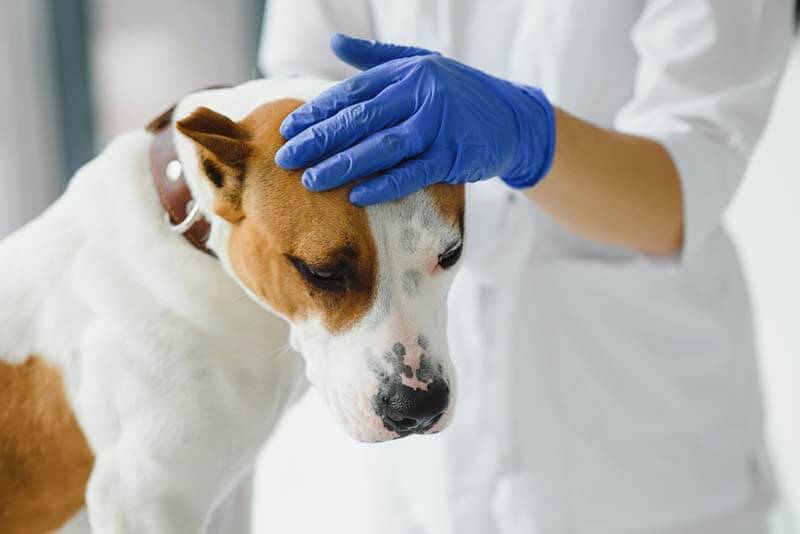
Reactive epilepsy
This form of epilepsy is considered conditional, since the convulsive syndrome occurs against the background of the action of any toxin or metabolic disorders. It often develops against the background of liver or kidney disease. In this case, convulsions may occur, as too many toxic substances accumulate in the dog’s body.
In puppies, especially in dwarf breeds, with relatively short fasting, hypoglycemia develops (a condition where glucose in the body drops sharply), which will also lead to convulsive syndrome. Or, for example, a lactating bitch may become deficient in calcium if there is little of it in the diet. This condition also occurs with convulsions.
With the establishment and elimination of the root cause, the forecasts are favorable.
Types of epileptic seizures
There are two main types of epileptic seizures – focal and generalized.
A focal epileptic seizure (or partial) is characterized by the appearance of seizures on only one side, since only one hemisphere of the brain is affected. In this case, the consciousness of the animal may be partially preserved. Any muscle contraction, involuntary salivation, pupil dilation, etc. occur on one side only. Partial seizures can become generalized.
A generalized epileptic seizure affects both hemispheres of the brain and can be observed in various manifestations:
tonic convulsions characterized by muscle tension. Often this is manifested by tilting the head, stretching the chest and pelvic limbs.
Clonic convulsions characterized by frequent muscle contractions. This is especially noticeable in the muscles of the muzzle, as the animal begins to click its teeth or make swimming movements.
Clonic-tonic characterized by a mixed alternation of two types of seizures.
Myoclonic seizures involve one muscle group. With these convulsions, consciousness, as a rule, is not disturbed.
Absance it is difficult to diagnose, because there are no seizures at this moment, the animal seems to freeze for a while, the reaction to external stimuli disappears. At the same time, a powerful electrical activity occurs in his head.
Atonic seizures – a condition when muscle tone is lost for a short period.

Causes of epilepsy in dogs
There are primary (or congenital) and secondary (acquired) causes of epilepsy.
The first type, presumably, is transmitted at the genetic level. The exact mechanisms of brain dysfunction often remain unknown, with about 55-60% of such animals. This is usually characteristic of idiopathic and cryptogenic epilepsy.
Secondary causes are factors that physically act on the brain and destroy it, namely:
Tumors in the brain;
Meningitis and encephalitis (inflammatory diseases of the brain);
Hemorrhages and thromboses in the structure of the brain;
Sequelae of traumatic brain injury;
Consequences of intoxication;
Congenital anomalies in the development of the brain;
Diseases of internal organs and endocrinological diseases that lead to metabolic disorders.
These causes lead to the development of structural or reactive epilepsy.

Risk groups
The following breeds are predisposed to epilepsy: golden retriever, labrador retriever, poodle (and their mixed breeds – toy poodles, maltipoo), border collie, cocker spaniel, rough collie, large swiss mountain dog, keeshond, beagle, irish wolfhound, german shepherd, dachshund, lagotto romagnolo, irish setter, rhodesian ridgeback.
Also at risk are brachycephalic breeds such as pugs, French bulldogs, and chihuahuas. These breeds are more likely to develop structural epilepsy than idiopathic epilepsy, due to the fact that they have a flattened muzzle, an irregular skull structure, and the brain is compressed, which leads to fluid retention in the brain and intracranial pressure.
Animals that have had head injuries are also at risk.

Epilepsy Symptoms in Dogs
The main signs and manifestations of epilepsy may be recurrent seizures. At the same time, the dogs stop hearing and seeing for a short time, their eyes become glassy, and they do not respond to the calls of the owner. At the time of convulsions, there may be involuntary defecation, urination, salivation.
But the owner is not always able to recognize seizures. Some convulsions occur with twitching of only the muscles of the muzzle, especially in the area of the lips and eyes, there may be a grin, chewing or twitching of the ears.
Changes in behavior before and after a convulsive syndrome manifested in the form of fear, aggression, panic in a dog. This is expressed in diligent sniffing, walking in a circle, the animal can look around and whine. Sometimes there is an unsteady gait, and from the outside it seems that the dog does not understand where it is. She may not recognize the owner for some time after convulsions, bark at the owner and not let him near her.

Diagnostics
Diagnosis of the disease is large-scale and is carried out in stages:
Collecting a detailed history of the animal: finding out how the seizures occur, how the animal feels after them, whether the dog’s relatives had similar symptoms.
It is necessary to carefully examine the animal, evaluate reflexes and reactions to external stimuli, determine the level of consciousness, measure blood pressure, temperature, etc.
They also take blood tests: general and biochemical. If epilepsy is suspected, advanced test profiles are preferred to assess electrolytes, glucose levels, and it is imperative to rule out liver disease. For this additional tests are taken for bile acids, ammonia. Thyroid stimulating hormone (TSH) and thyroxine (T4) to rule out thyroid problems.
Testing by polymer chain reaction (PCR) to exclude diseases of viral origin (for example, canine distemper, toxoplasmosis).
The final stage of diagnosis is magnetic resonance imaging (MRI) of the brain with contrast, analysis of cerebrospinal fluid. This is necessary to exclude infectious or structural causes in the development of seizures.
Electroencephalography (EEG) in veterinary medicine is a difficult method, since if the animal is conscious, then too many errors occur. However, if successful, it allows you to find an epileptic focus.
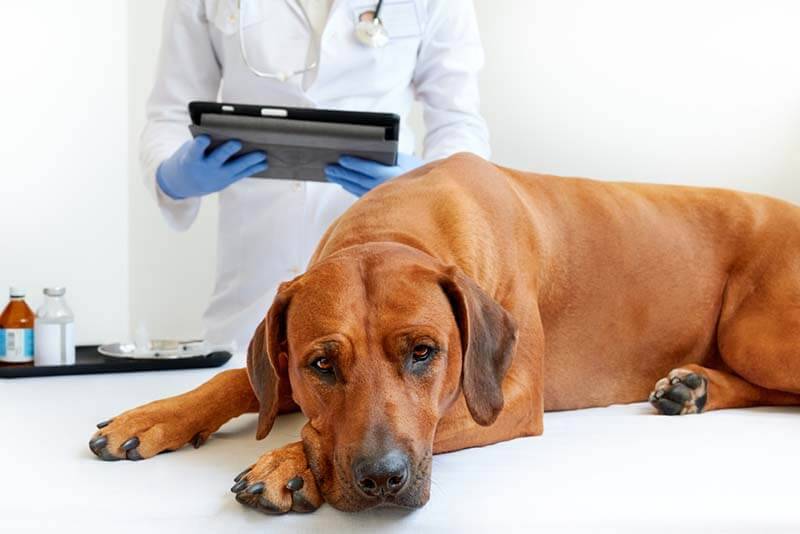
Treatment of epilepsy in dogs
For the treatment of epilepsy in dogs, the following drugs and drugs from the group of anticonvulsants are used:
Levetiracetam (Keppra and analogues);
Phenobarbital (in Russia under the trade name Pagluferal);
Preparations based on potassium bromide;
Zonisamide (trade name Zonegran – imported from Japan, so it is not widely used in Russia).
The drugs listed are first choice drugs. The first two substances are most often used. Gabapentin may be used as adjuvant therapy. But sometimes dogs become resistant to it, doctors may increase dosages, change the drug, or combine several anticonvulsants. With the development of epistatus (a condition when an animal immediately enters from one attack into another or an attack lasts more than 5 minutes), the dog is placed in a hospital under the supervision of doctors. In parallel, diuretics can be used in therapy to prevent cerebral edema. If the dog could have eaten a poison that affects the nervous system, then antidotes (antidotes) and therapy aimed at removing intoxication are also used. For example, if you suspect a structural or reactive form of epilepsy.

Treatment of epilepsy in dogs should be prescribed by a veterinary neurologist. It is necessary not only to choose the minimum effective dosage, but also to monitor blood counts in the future. So, for example, when prescribing phenobarbital, veterinarians without fail recommend monitoring its blood level, since the substance is excreted by the liver, and in some animals standard doses do not lead to relief of seizures, since the liver quickly neutralizes the drug.
Self-cancellation of drugs is also unacceptable, as a fatal epileptic seizure may develop, because drugs with a cumulative effect, even the introduction of high doses, do not allow you to remove strong electrical activity in the brain.
What should I do if my dog has an epileptic seizure?
First of all, it is important not to get confused by the owner.
It is necessary to place the animal in a safe place, that is, place it on the floor, move away from sharp corners or objects that can be hit.
If possible, dim the lights and minimize noise (turn off the TV, music, loud home electronics).
At the very moment of the attack, you will not be able to help the animal in any way, trying to stick out the tongue or fix the pet does not just make no sense, but can lead to traumatization of both the owner and the animal.
It would be better if you can capture the attack on video. This material is extremely informative for a veterinarian. If the attack turns into epistatus, then the animal must be urgently delivered to the clinic.
epilepsy in puppies
Puppies also have seizures, but in order to make a diagnosis of epilepsy, a number of other diseases and factors that can lead to this condition must be ruled out. Most often, puppy seizures occur due to a lack of glucose in the body, low levels of calcium or potassium, or in response to the action of some kind of toxin. Epilepsy is usually diagnosed in babies from 6 months of age, but the diagnosis can be made earlier if all other causes of seizures are ruled out.

How long do dogs with epilepsy live?
In some sources, there is a figure – 7 years, but there is no exact confirmation of this. Based on practice, it can be said that dogs can live longer from the time of diagnosis. The cause of the development of epilepsy will affect the life expectancy of a pet.
In reactive and symptomatic epilepsy, it is important to identify the underlying cause and treat it if it is curable. It is also important when the disease manifested itself, and with what frequency convulsions occur. The more frequent, stronger and longer the attacks, the worse the prognosis. It will also be important how the owners fulfill the doctor’s prescriptions. Dogs can live long and happy lives with the right therapy and preventive measures to prevent seizures.

Prevention
In terms of prevention, we can only protect the dog from injury and poisoning.
Therefore, it is recommended to wear a muzzle and a leash for a walk so that the dog does not pick up anything, and the risk of escape, which often leads to injury, should also be minimized.
It is recommended to protect the animal from overheating in the summer, especially for bracheocephalic breeds and breeds with a pronounced undercoat. It is very important to note that in case of a head injury, an immediate visit to the clinic is indicated in order to minimize the consequences, possible cerebral edema.
It is possible to prevent true epilepsy only at the breeding stage. The owner sometimes does not even suspect the presence of such a diagnosis in the pedigree of the animal, so here a great responsibility lies with the breeder, who must correctly select dogs for breeding.

Care
After an attack, it is necessary to talk with the animal, in a quiet voice, try to calm it down if it is overexcited.
Care should be taken, the dog may be frightened, since the consciousness after the attack is confused and it does not always immediately recognize the owner.
It is not necessary to give drugs or water during an attack or immediately after.
Since the act of swallowing may be impaired. This will only cause the substance to be inhaled or cause injury to the wearer’s hands when trying to open the jaw. That is why in the clinic doctors inject everything intravenously or rectally.
Fix the date, time and duration of attacks, write down what actions were taken before the attack. All of this information will help your doctor and you recognize a possible trigger, after which a seizure develops. This will minimize further provoking seizures.
If the dog’s seizures are under control, there is no violation in taking the drugs, then it does not require additional care.
Summary
Epilepsy is a common disease in pets. Seizures are the main symptom of epilepsy in dogs. But not every seizure is true epilepsy.
To establish a correct and final diagnosis, it is necessary to complete each stage of the diagnosis in order to subsequently prescribe the correct therapy. Self-medication or failure to follow the recommendations of a doctor can lead to the death of a pet.
If your dog has a seizure, then lay it on its side on the floor and videotape everything. Trying to hold or climb into the mouth is not worth it, this will only lead to complications and injuries.
If the convulsions last more than 5 minutes or recur, then it is urgent to take the dog to the clinic and hospitalize it until the condition stabilizes.
With epilepsy, an animal can live a long and happy life, but the results of examinations and the correct implementation of all doctor’s prescriptions affect the prognosis.
In the video you can see what an epileptic seizure looks like in dogs.
Answers to frequently asked questions
Sources:
Practical Guide to Canine and Feline Neurology, 3rd Edition, Curtis W.Dewey, Ronaldo C. da Costa, 2015
Handbook of Veterinary Neurology, Fourth Edition, Michael D. Lorenz, Joe N. Kornegay, 2004
Neurology of dogs and cats, S. Crisman, K. Mariani, S. Platt, R. Clemons, 2016.






